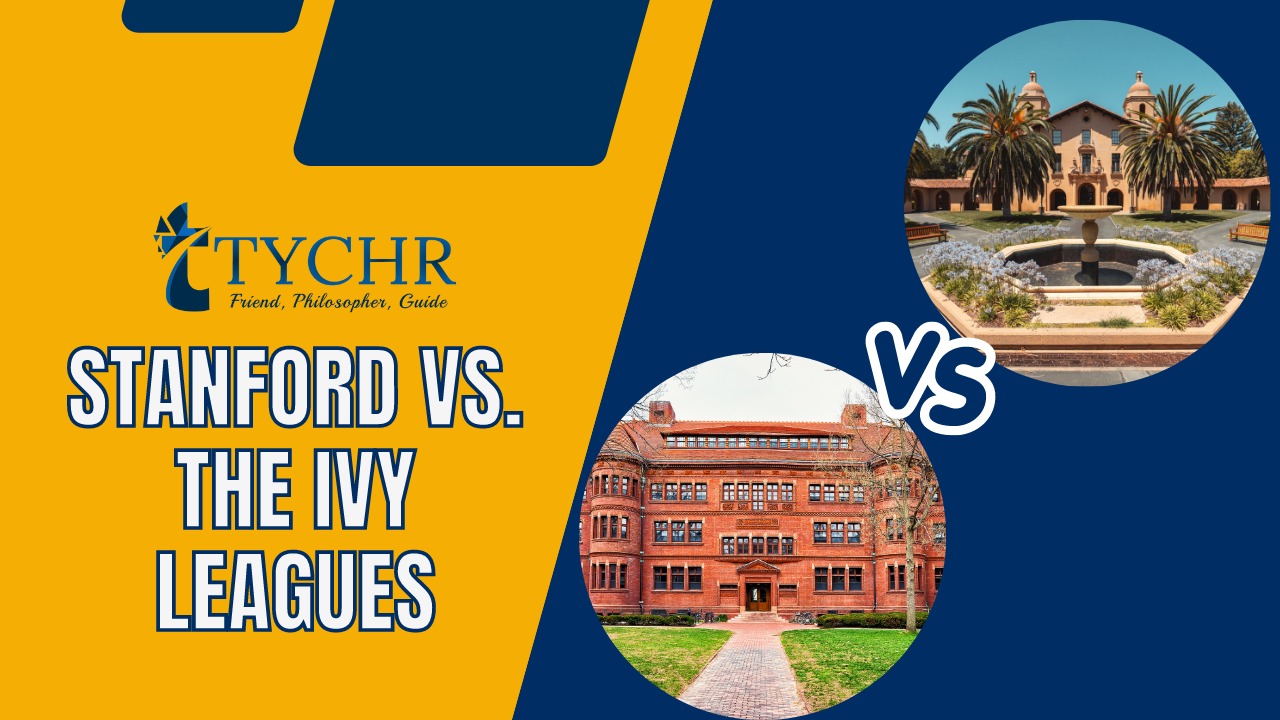Table of Contents
When it comes to prestigious universities, Stanford and the Ivy League schools often top the list. While the Ivy League is a renowned group of eight private institutions located primarily in the northeastern United States, Stanford University stands out as a leading research university on the West Coast. In this comprehensive blog post, we’ll explore the distinct characteristics that set Stanford apart from the Ivy League schools, shedding light on Stanford’s unique strengths and contributions to higher education.
Stanford vs Ivy Leagues:
- The Silicon Valley Advantage: One key factor that sets Stanford apart is its location in the heart of Silicon Valley, a global hub for technology and innovation. This proximity offers students unparalleled access to internships, job opportunities, and collaborations with leading tech companies and startups. Stanford’s strong connections to the innovation and entrepreneurship ecosystem contribute to its vibrant culture of creativity and technological advancement. The university’s close ties with industry leaders allow for practical applications of knowledge and foster an entrepreneurial mindset among students.
- Interdisciplinary Approach: While the Ivy League schools excel in their individual disciplines, Stanford is known for its commitment to interdisciplinary education and research. Stanford encourages students to explore diverse academic interests, combining fields such as computer science, engineering, humanities, and social sciences. This approach fosters cross-pollination of ideas and prepares students to tackle complex real-world challenges that often require a multidisciplinary approach. Stanford’s interdisciplinary programs, such as Symbolic Systems and Science, Technology, and Society, provide unique opportunities for students to integrate knowledge from multiple domains.
- Entrepreneurial Mindset: Stanford’s entrepreneurial spirit sets it apart from the Ivy League institutions. The university actively promotes innovation and supports student-led startups through initiatives like the Stanford StartX accelerator and various entrepreneurship programs. Stanford’s emphasis on entrepreneurship goes beyond just business and extends to other disciplines as well. Students are encouraged to think creatively, take risks, and translate their ideas into impactful ventures. The Stanford ecosystem provides a supportive environment where aspiring entrepreneurs can access resources, mentorship, and funding to bring their visions to life.
- Collaborative Culture: Stanford’s collaborative culture is another standout feature. While Ivy League schools often emphasize competition, Stanford fosters a supportive and collaborative environment. The university encourages teamwork, interdisciplinary projects, and a sense of community among its students and faculty. Collaborative research and learning experiences are highly valued at Stanford, enabling students to work together on complex problems and benefit from diverse perspectives. The university’s collaborative ethos creates a cooperative and inclusive atmosphere that enhances the overall educational experience.
- Commitment to Diversity and Inclusion: Stanford’s dedication to diversity and inclusion distinguishes it from some of the Ivy League institutions. The university strives to create an inclusive community that embraces individuals from different backgrounds, cultures, and perspectives. Stanford actively recruits and supports students from underrepresented communities, and offers resources and programs to foster a sense of belonging. The commitment to diversity enriches the educational experience, fosters a more comprehensive understanding of the world, and prepares students to thrive in diverse and global environments.
- West Coast Influence: The unique West Coast vibe adds to Stanford’s distinctive character. The university reflects the region’s emphasis on innovation, sustainability, and cultural diversity. Stanford’s connection to the dynamic West Coast community provides students with a distinct perspective and a range of opportunities. The natural beauty of the area, along with the outdoor recreational activities available, contributes to a well-rounded student experience. The West Coast influence on Stanford’s academic programs and cultural milieu adds a refreshing dimension to the university’s identity.
- Research and Innovation: Stanford’s commitment to cutting-edge research and innovation is unparalleled. The university boasts a robust research infrastructure and attracts world-class faculty and researchers across various fields. Stanford’s research centers and institutes tackle global challenges and drive technological advancements. Students have the opportunity to engage in groundbreaking research projects and contribute to advancements in their respective fields. Stanford’s research endeavors span a wide range of disciplines, from biomedical engineering to artificial intelligence, from climate change to social sciences. The university’s collaborative and interdisciplinary approach encourages students to explore research questions from multiple perspectives, pushing the boundaries of knowledge and making significant contributions to society.
- Global Engagement and Study Abroad: Stanford’s commitment to global engagement sets it apart from many Ivy League schools. The university offers a wide range of study abroad programs that allow students to immerse themselves in different cultures, gain a global perspective, and develop a deeper understanding of international issues. These programs provide opportunities for academic exploration, language immersion, and cultural exchange. Stanford’s global engagement initiatives extend beyond study abroad, including international internships, research collaborations, and service-learning experiences, fostering a global mindset among students.
- Flexibility and Exploration: Stanford’s academic flexibility stands out compared to the Ivy League schools. While Ivy League institutions often have a more structured curriculum, Stanford encourages students to explore their academic interests and design their educational journey. Students have the freedom to choose from a wide range of courses and majors, allowing them to tailor their academic experience to their passions and goals. This flexibility promotes intellectual curiosity, interdisciplinary learning, and personal growth.
- Technological Resources and Innovation Spaces: Stanford’s commitment to providing state-of-the-art technological resources and innovation spaces enhances the learning and research experiences of its students. The university offers cutting-edge laboratories, maker spaces, and collaborative workspace that foster creativity, experimentation, and hands-on learning. Students have access to advanced technologies and tools that enable them to bring their ideas to life and engage in innovative projects across various disciplines.
- Emphasis on Personal Development and Wellness: Stanford recognizes the importance of holistic student development and prioritizes student well-being. The university offers a wide range of resources and programs to support students’ physical, mental, and emotional well-being. From counseling services to wellness workshops, Stanford prioritizes the health and happiness of its student community. Additionally, the university provides ample opportunities for personal growth through leadership development programs, extracurricular activities, and community service initiatives.
- Alumni Network and Career Opportunities: Stanford’s strong and influential alumni network is a significant advantage for its students and graduates. Stanford alumni are known for their accomplishments and success across various industries, including technology, finance, entrepreneurship, academia, and the arts. The extensive network provides students with mentorship, internship opportunities, and career connections that can be instrumental in launching their professional journeys. Stanford’s career services center offers comprehensive support and resources to guide students through career exploration, internships, job placements, and post-graduation opportunities.

Why is Stanford not an Ivy League?
Stanford University is not a member of the Ivy League because it is not one of the eight institutions that make up the Ivy League consortium. The Ivy League is an athletic conference that was formed in 1954 and consists of Harvard University, Yale University, Princeton University, Columbia University, Brown University, Dartmouth College, Cornell University, and the University of Pennsylvania.The Ivy League was originally formed as a sports league, but over time, the term “Ivy League” has come to represent a group of prestigious and academically rigorous universities with long histories and established reputations. While Stanford is widely regarded as one of the top universities in the world and shares many qualities with Ivy League institutions, it is an independent university located on the West Coast, separate from the Ivy League consortium.
Stanford University was founded in 1885 by Leland Stanford and his wife Jane Stanford. It has since developed its own distinct identity, academic programs, and traditions. Although not an Ivy League school, Stanford is often mentioned in the same conversations as Ivy League institutions due to its academic excellence, research contributions, and global reputation. It’s worth noting that while the Ivy League schools have historical significance and a certain prestige associated with them, there are many other universities, including Stanford, that offer outstanding educational opportunities and are highly regarded in their own right. Each university has its unique strengths and contributions to higher education.
Acceptance Rates of Stanford vs Ivy Leagues
| Acceptance Rate | Tuition Fee | Enrollment (undergrad) | |
| Harvard University | 3.2% | $57,261 | 7,153 |
| Columbia University | 3.7% | $65,524 | 8,148 |
| Stanford | 3.9% | $56,169 | 7,645 |
| Princeton University | 4.4% | $57,140 | 5,321 |
| Yale University | 4.5% | $62,250 | 6,536 |
| Brown University | 5.0% | $65,146 | 7,349 |
| University of Pennsylvania | 5.9% | $63,452 | 9.962 |
| Dartmouth College | 6.2% | $62,430 | 4,556 |
| Cornell University | 6.9% | $63,200 | 15,503 |
US News Ranking for Stanford vs Ivy Leagues – Global
| Harvard University | #1 |
| Stanford University | #3 |
| Columbia University | #7 |
| Yale University | #11 |
| University of Pennsylvania | #15 |
| Princeton University | #16 |
| Cornell University | #21 |
| Brown University | #129 |
| Dartmouth College | #261 |
US News Ranking for Stanford vs Ivy Leagues – National
| Princeton University | #1 |
| Harvard University | #3 |
| Stanford University | #3 |
| Yale University | #3 |
| University of Pennsylvania | #7 |
| Dartmouth College | #12 |
| Brown University | #13 |
| Cornell University | #17 |
| Columbia University | #18 |
Stanford University’s unique characteristics and strengths set it apart from the Ivy League schools. Its location in Silicon Valley, interdisciplinary approach, entrepreneurial mindset, collaborative culture, commitment to diversity and inclusion, West Coast influence, research and innovation endeavors, global engagement opportunities, academic flexibility, technological resources, emphasis on personal development and wellness, and influential alumni network all contribute to Stanford’s distinct identity and excellence in higher education. Whether one chooses an Ivy League institution or Stanford, both offer exceptional academic environments, but Stanford’s unique attributes and contributions make it a compelling choice for students seeking a different educational landscape on the West Coast.








